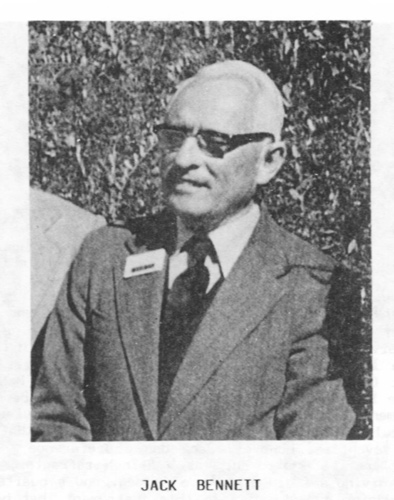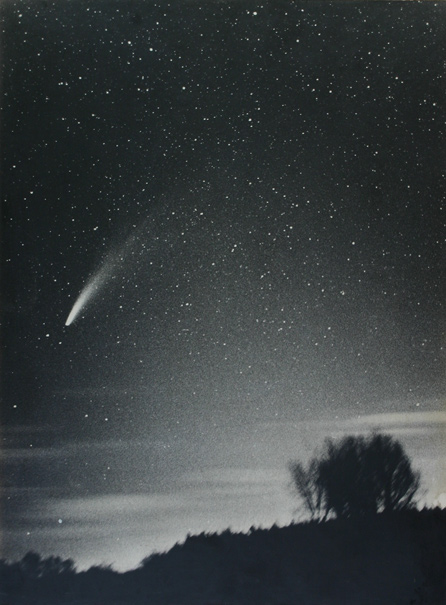|
| |
The Jack Bennett Catalogue of Southern
Hemisphere Objects
An Astrophotography Essay
Background
For two decades, starting in the late 1960's, the
southern sky was patrolled by a dedicated South African comet-hunter named Jack
Bennett. Using a 5-inch low-power refractor from his backyard he discovered two
comets. Jack also picked up a 9th magnitude
supernova in NGC 5236 (M83), becoming the first person ever to visually discover
a supernova since the invention of the telescope.
John Caister Bennett was born on April 6th, 1914
in Estcourt Natal; his mother was British and his father was from Longford,
Tasmania. A long-standing member of the Astronomical
Society of Southern Africa (ASSA), he was elected President in 1969. The Society
awarded him the prestigious Gill Medal for services to astronomy in 1970 and in
1986 he received an Honorary Degree of Master of Science from the University of
Witwatersrand. In 1989, at the recommendation of Rob McNaught of Siding Springs
Observatory, the asteroid VD 4093 was named after him. Bennett passed away on May 30th, 1990 in Pretoria.
|

This picture was taken on occasion of Jack's visit to
the USA to accept an award for the M83 supernova visual discovery.
Source: Monthly Notes of the Astronomical
Society of
Southern Africa (MNASSA), Volume 49, No. 9, page 114 |

This photo, taken in 1977, shows Bennett at the eyepiece of the 12-inch
telescope belonging to the Pretoria Centre of the ASSA. In Bennett's
handwriting, and initialled by him, on the back of the photograph, in his
typical humorous shy style: "With antiquated observer." |
Jack was a skilled observer and in the spirit
of Charles Messier drew up two lists of southern objects that appeared
comet-like in his telescope. He referred to them as "shades of
Messier...". His first list (Bennett, 1969) was published four
months before he discovered his first comet. The supplementary list (Bennett,
1974) was followed three months later by his second discovery. These two
lists have been combined to form the Bennett Catalogue (Table below).
Bennett's Catalogue reads like the "Who's Who of
the (Southern) Deepsky". Among the 152 objects are the Tarantula, Omega
Centauri, 47 Tucanae, Sombrero, Helix, Centaurus A and the Silver Coin. Twenty-six of
Messier's objects are listed. Bennett noted that including such bright objects
may be unnecessary, but added: "it is surprising how easily even these can
be mistaken for comets when seen at low altitudes and poor
conditions." Almost half the objects in Bennett's list
are globular clusters, which makes sense since these bear a striking resemblance
to comets. The constellation richest in Bennett objects is Sagittarius, followed
by Ophiuchus. Bennett wrote that "the constellations Scorpio, Ophiuchus and
Sagittarius . . contain a bewildering variety of comet-like objects. These are
mostly globular clusters and all except the largest defy attempts to distinguish
them from tailless comets. This relatively small area of sky contains about a
third of all the comet-like objects visible with small telescopes south of the
equator." Dorado also contains many "Bennetts" - five galaxies
and six clusters and nebulae. The latter lie within the Large Magellanic Cloud
which, according to Bennett, "should normally be avoided like the plague by
anyone looking for comets. There are, however, a few objects on the outskirts of
the Clouds which are regularly encountered in comet sweeps, and these have been
included in the list, if only as a warning to the observer of the perils that
lie ahead of him!"
The Essay
| When I was a young student in my native Belgium,
Jack Bennett's first comet discovery - C/1969 Y1, the great comet Bennett
that reached mag 0 (!) in March-April 1970
- constituted a landmark and major motivation point in my personal
astrophotography roadmap.
The image of Comet Bennett on the right was taken in 1970
near the town of Waasmunster in Flanders (Belgium) using Kodak Tri-X
B&W 400 ASA film developed in Promicrol, a popular astrophotography
methodology in those years. The camera was a Pentax Spotmatic SLR
camera riding piggy-back on an 4" Polarex-Unitron refractor and
mount. I made a whole
stack of 30 x 40 cm prints and offered them for sale to help finance my
astrophotography endeavors.
It is thus with a special dedication
and fondness that I go about imaging and documenting Jack's collection of
"comet-like" objects.
This is a work in progress: the table below lists all 152 Bennett
objects. A click on the Bennett number in the first column will take you
to the image. The second column shows the corresponding NGC number for all but
three objects and other designations if available. My special thanks to
South-African Auke Slotegraaf for the background info on
Jack Bennett and especially for the two images of the late Mr. Bennett, courtesy
of ASSA (Astronomical Society of Southern Africa) http://www.saao.ac.za/assa
.
Daniel Verschatse, Santiago de Chile in March of 2005
|

|
|
Bennett
1
2
3
4
5
6
7
8
9
10
10a
11
12
13
14
14a
15
16
17
18
19
19a
20
21
21a
22
23
24
25
25a
26
27
28
29
30
31
32
33
34
35
36
36a
37
37a
38
39
40
40a
41
41a
41b
42
43
44
45
46
47
48
49
50
51
52
53
54
55
56
57
58
59
59a
60
61
62
63
63a
64
65
66
67
68
69
70
71
72
72a
73
74
75
76
77
78
79
79a
79b
80
81
82
83
84
85
86
87
88
89
90
91
91a
92
93
94
95
96
97
98
98a
98b
99
100
101
102
103
104
105
106
107
107a
108
109
110
111
112
112a
113
114
115
116
117
118
119
120
121
122
123
124
125
126
127
128
129
129a
129b
130
|
Other designation(s)
NGC 55
NGC 104, 47 Tuc
NGC 247
NGC 253, Sculptor, Silver Coin Gal.
NGC 288
NGC 300
NGC 362
NGC 613
NGC 1068, M 77
NGC 1097
NGC 1232
NGC 1261
NGC 1291
NGC 1313
NGC 1316
NGC 1350
NGC 1360
NGC 1365
NGC 1380
NGC 1387
NGC 1399
NGC 1398
NGC 1404
NGC 1433
NGC 1512
NGC 1535
NGC 1549
NGC 1553
NGC 1566
NGC 1617
NGC 1672
NGC 1763
NGC 1783
NGC 1792
NGC 1818
NGC 1808
NGC 1851
NGC 1866
NGC 1904, M 79
NGC 2070, Tarantula Nebula, 30 Dor
NGC 2214
NGC 2243
NGC 2298
NGC 2467
NGC 2489
NGC 2506
NGC 2627
NGC 2671
NGC 2808
NGC 2972
NGC 2997
NGC 3115
NGC 3132, 8-Burst, S. Ring Nebula
NGC 3201
NGC 3242, Ghost of Jupiter
NGC 3621
Melotte 105
NGC 3960
NGC 3923
NGC 4372
NGC 4590, M 68
NGC 4594, M 104, Sombrero Gal.
NGC 4697
NGC 4699
NGC 4753
NGC 4833
NGC 4945
NGC 4976
NGC 5061
NGC 5068
NGC 5128, Centaurus A
NGC 5139, Omega Centauri
NGC 5189, Spiral Nebula
NGC 5236, M 83, S.Pinwheel
NGC 5253
NGC 5286
NGC 5617
NGC 5634
NGC 5824
NGC 5897
NGC 5927
NGC 5986
NGC 5999
NGC 6005
Tr 23 (Trumpler)
NGC 6093, M 80
NGC 6101
NGC 6121, M 4
NGC 6134
NGC 6144
NGC 6139
NGC 6171, M 107
NGC 6167
NGC 6192
NGC 6218, M 12
NGC 6216
NGC 6235
NGC 6254, M 10
NGC 6253
NGC 6266, M 62
NGC 6273, M 19
NGC 6284
NGC 6287
NGC 6293
NGC 6304
NGC 6316
NGC 6318
NGC 6333, M 9
NGC 6356
NGC 6352
NGC 6362
NGC 6388
NGC 6402, M 14
NGC 6397
NGC 6440
NGC 6445
NGC 6441
NGC 6496
NGC 6522
NGC 6528
NGC 6544
NGC 6541
NGC 6553
NGC 6569
NGC 6584
NGC 6603, in M 24
NGC 6618, M 17
NGC 6624
NGC 6626, M 28
NGC 6638
NGC 6637, M 69
NGC 6642
NGC 6652
NGC 6656, M 22
NGC 6681, M 70
NGC 6705, M 11
NGC 6712
NGC 6715, M 54
NGC 6723
NGC 6744
NGC 6752
NGC 6809, M 55
NGC 6818
NGC 6864, M 75
NGC 6981, M 72
NGC 7009, Saturn Nebula
NGC 7089, M 2
NGC 7099, M 30
NGC 7293, Helix Nebula
NGC 7410
IC 1459
NGC 7793
|
R.A.
00:14:54
00:24:06
00:47:06
00:47:36
00:52:48
00:54:54
01:03:12
01:34:18
02:42:42
02:46:18
03:09:48
03:12:18
03:17:18
03:18:18
03:22:42
03:31:06
03:33:18
03:33:36
03:36:30
03:37:00
03:38:30
03:38:54
03:38:54
03:42:00
04:03:54
04:14:12
04:15:42
04:16:12
04:20:00
04:31:42
04:45:42
04:56:48
04:58:54
05:05:12
05:04:12
05:07:42
05:14:06
05:13:30
05:24:30
05:38:36
06:12:48
06:29:48
06:49:00
07:52:36
07:56:12
08:12:00
08:37:18
08:46:12
09:12:00
09:40:18
09:45:36
10:05:12
10:07:00
10:17:36
10:24:48
11:18:18
11:19:39
11:50:52
11:51:00
12:25:48
12:39:30
12:40:00
12:48:36
12:49:00
12:52:24
12:59:36
13:05:24
13:08:36
13:18:06
13:18:54
13:25:30
13:26:48
13:33:30
13:37:00
13:39:54
13:46:24
14:29:48
14:29:36
15:04:00
15:17:24
15:28:00
15:46:06
15:52:12
15:55:48
16:01:30
16:17:00
16:25:48
16:23:36
16:27:42
16:27:18
16:27:42
16:32:30
16:34:24
16:40:18
16:47:12
16:49:24
16:53:24
16:57:06
16:59:06
17:01:12
17:02:36
17:04:30
17:05:12
17:10:12
17:14:30
17:16:36
17:17:48
17:19:12
17:23:36
17:25:30
17:31:54
17:36:18
17:37:36
17:40:42
17:48:54
17:49:12
17:50:12
17:59:00
18:03:36
18:04:48
18:07:18
18:08:00
18:09:18
18:13:36
18:18:36
18:18:24
18:20:48
18:23:42
18:24:30
18:30:54
18:31:24
18:31:54
18:35:48
18:36:24
18:43:12
18:51:06
18:53:06
18:55:06
18:59:36
19:09:48
19:10:54
19:40:00
19:44:00
20:06:06
20:53:30
21:04:12
21:33:30
21:40:24
22:29:36
22:55:00
22:57:00
23:57:48
|
Dec.
-39:11
-72:05
-20:46
-25:17
-26:35
-37:41
-70:51
-29:25
-00:01
-30:17
-20:35
-55:13
-41:08
-66:30
-37:12
-33:38
-25:51
-36:08
-34:59
-35:31
-35:27
-26:20
-35:35
-47:13
-43:21
-12:44
-55:36
-55:47
-54:56
-54:36
-59:15
-66:24
-66:00
-37:59
-66:24
-37:31
-40:03
-65:28
-24:33
-69:05
-68:16
-31:17
-36:00
-26:23
-30:04
-10:47
-29:57
-41:53
-64:52
-50:20
-31:11
-07:43
-40:26
-46:25
-18:38
-32:49
-63:30
-55:41
-28:48
-72:40
-26:45
-11:37
-05:48
-08:40
-01:12
-70:53
-49:28
-49:30
-26:50
-21:02
-43:01
-47:29
-65:59
-29:52
-31:39
-51:22
-60:43
-05:59
-33:04
-21:01
-50:40
-37:47
-56:28
-57:26
-53:32
-22:59
-72:12
-26:32
-49:09
-26:02
-38:51
-13:03
-49:36
-43:22
-01:57
-44:44
-22:11
-04:06
-52:43
-30:07
-26:16
-24:46
-22:42
-26:35
-29:28
-28:08
-39:27
-18:31
-17:49
-48:25
-67:03
-44:44
-03:15
-53:40
-20:22
-20:01
-37:03
-44:16
-30:02
-30:03
-25:00
-43:42
-25:54
-31:50
-52:13
-18:25
-16:11
-30:22
-24:52
-25:30
-32:21
-23:29
-32:59
-23:54
-32:18
-06:16
-08:42
-30:29
-36:38
-63:51
-59:59
-30:58
-14:09
-21:55
-12:32
-11:22
-00:49
-23:11
-20:48
-39:40
-36:28
-32:35
|
|
| <end> |
|
|
|
|
|
|